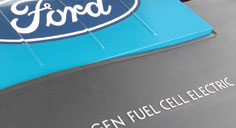Investor News
Investor RelationsCommon Questions About Fuel Cell Vehicles
As our fuel cell technology advances, our customers have become increasingly interested and sent us their questions. We've answered the most frequently asked questions below.
 Does your fuel cell have a battery like a hybrid electric vehicle?
Does your fuel cell have a battery like a hybrid electric vehicle?

No, all of the energy to power the wheels comes from the fuel cell.
Where are the Ballard stacks?
In the FCV, under the front seats. In the P2000, they're in the trunk under the tanks.
Who supplies the fuel cell stacks?
The Focus FCV has a Ballard 900 series stack.
Where does Ford get the hydrogen for the fuel cell vehicle?
Messer and Air Products make most of the hydrogen we use. Methods of producing hydrogen include: natural gas reformation and electrolysis of water.
Why was the Focus body chosen for the new Ford fuel cell vehicle?
The Focus best meets our target customers' needs for performance, comfort and utility.
Why was hydrogen chosen as the fuel for the Focus FCV?
Direct-hydrogen offers the most environmental benefit and it is the most practical and reliable of competing fuel cell technologies right now.
What is the difference between the Focus FCV and the Ford P2000?
The Ford P2000 is built on a lightweight research platform. The Focus FCV is based on the Ford Focus and is designed for production.
What is the range of the Focus FCV?
100 miles—additional specs can be found in the FCV vehicle specifications section.
Where can I see the Focus FCV or P2000?
Check out the Road Show schedule to find out when the vehicles will be in your neighborhood!
Where are consumers going to find hydrogen to refuel?
The lack of refueling infrastructure is one of the major challenges facing commercialization of fuel cell vehicles. Initially, fuel cell vehicles will be marketed as fleets to organizations that have the ability to install hydrogen-refueling stations.
Investor News
-

Ford Motor Company’s August Sales Up 11 Percent; Ford Brand Cars, Utilities, Trucks Increase, Along with Lincoln
September 01, 2011 -

Ford, Toyota to Collaborate on Developing New Hybrid System for Light Trucks, SUVs; Future Telematics Standards
August 22, 2011 -

Ford Continues China Expansion, Sales Up 13% This Year
August 11, 2011 -

Ford Drops Price of SYNC by $100, Making Hands-Free, Voice-Activated In-Car Connectivity More Affordable, Available to All
August 01, 2011
Financial Reports
 Annual Report 2010
Annual Report 2010
|
FLIP-BOOK* | |
|---|---|---|
| Flip-Book | ||
| *Interactive flip-book format requires Flash Player |
||
- Investor Resources
- Contact Us




